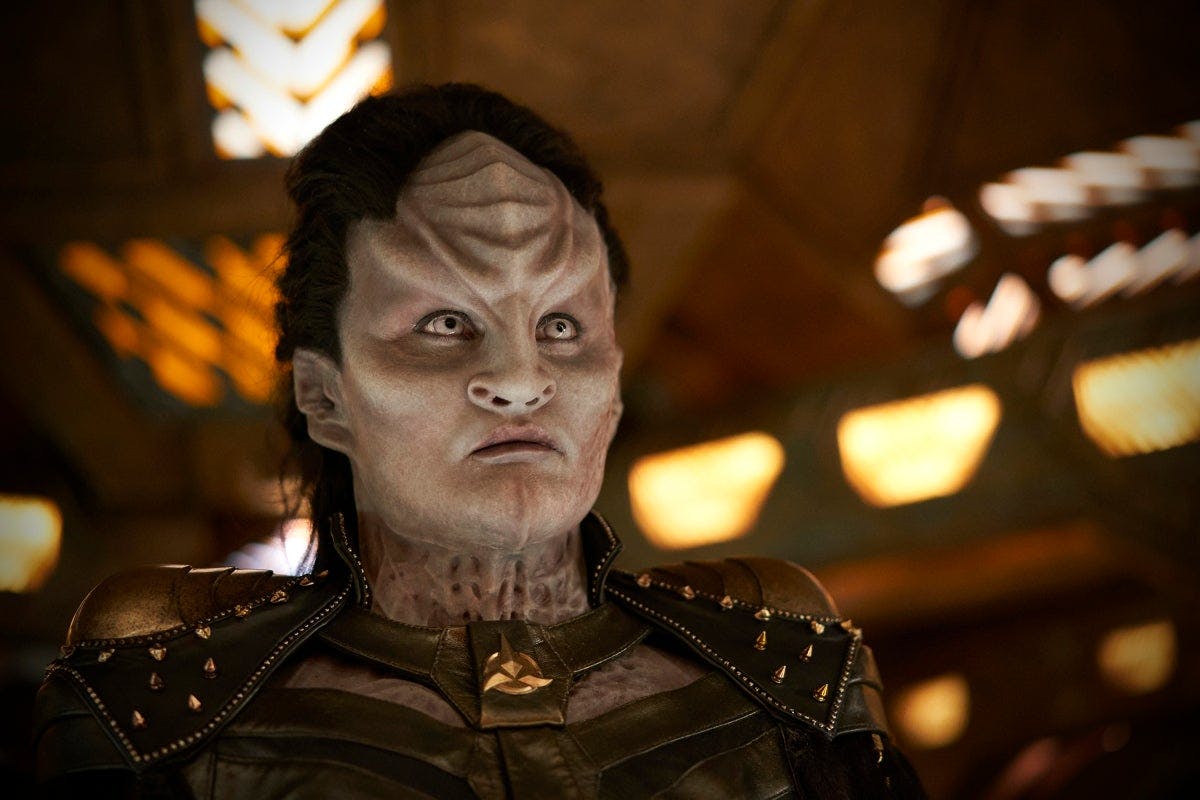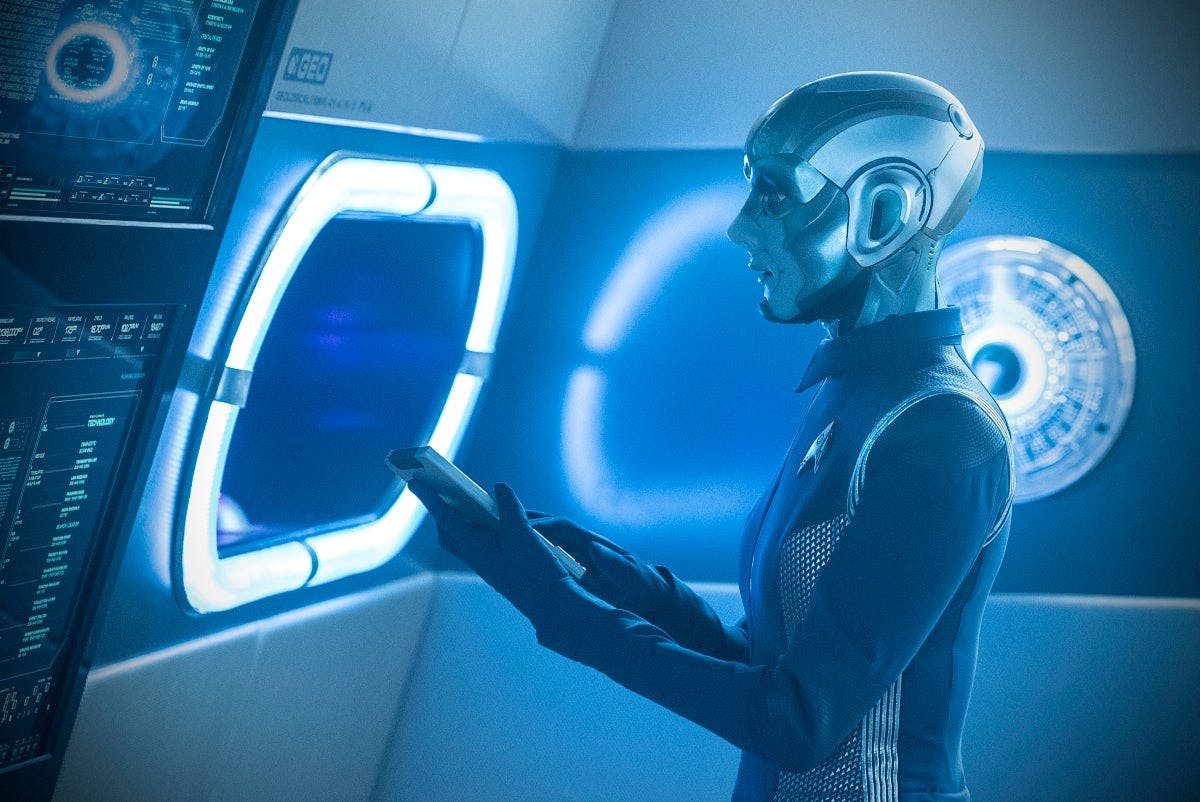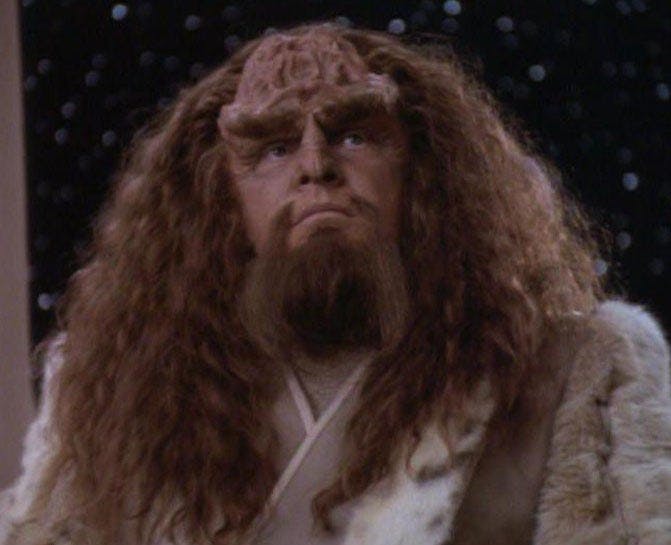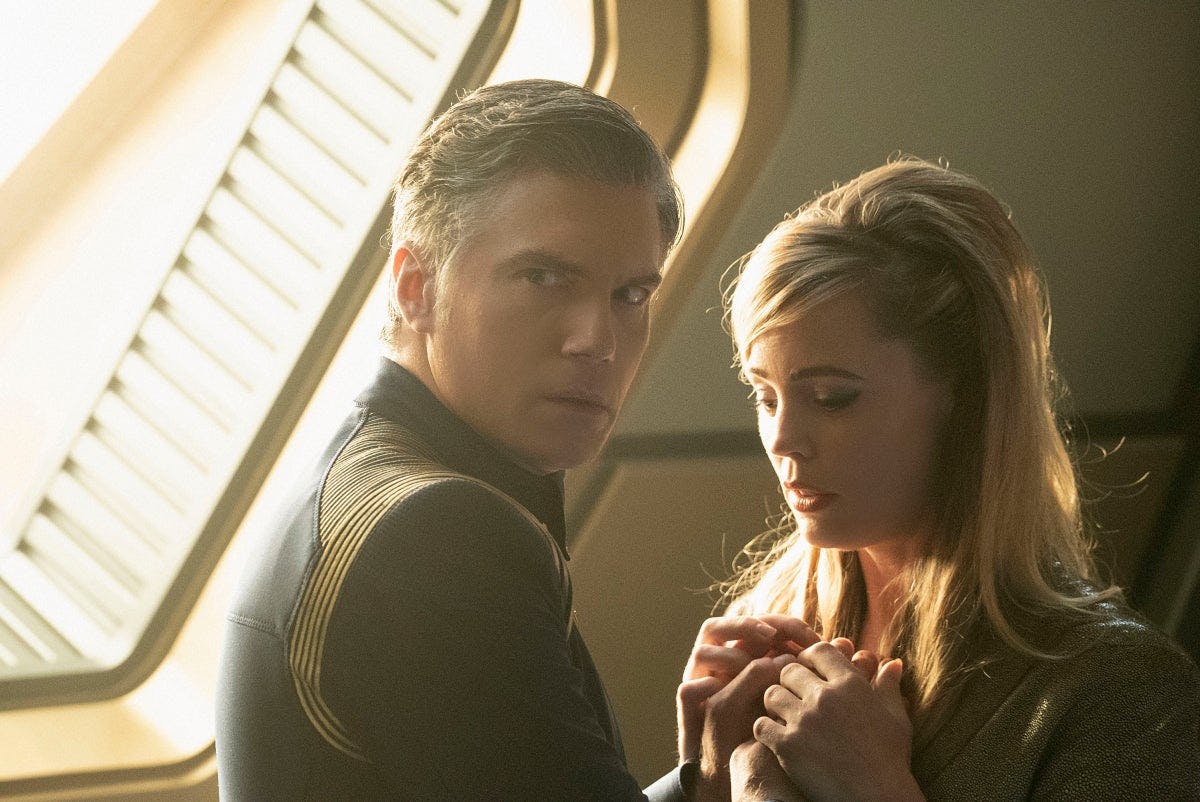Published Jun 6, 2019
Designing The Future: 'Discovery''s Brilliant Design Team Talks Makeup and Costumes at Paley
Gersha Phillips, Glenn Hetrick and James MacKinnon, discussed it all with L’Rell herself, Mary Chieffo.

StarTrek.com
For a third time and final, the Paley Center welcomed the cast and creatives of Star Trek: Discoveryfor a night of screenings and discussions. Last night, fans of the show came out to watch season two's "If Memory Serves," and listen to a lively discussion between costume designer Gersha Phillips and prosthetic makeup department co-heads Glenn Hetrick and James MacKinnon, moderated by L’Rell herself, Mary Chieffo. Like the firsttwo events in this Emmys For Your Consideration event, visitors were invited to explore the center’s Star Trek: Discovery - Fight For The Future exhibit before and after the main events.
If you weren’t able to make it, there’s nothing to worry about. We have a quick recap of the panel’s highlights below, and if you’re in the L.A. area you can check out Fight For The Future now through July 7th, at the Paley Center in Beverly Hills.

StarTrek.com
Glenn Hetrick: [Alchemy is my] prosthetics [and] makeup effects outfit, and we specialize in everything from... we've done a lot of forensic work over the years at shows like CSI New York, and of course lots of monsters, and creatures, and aliens.
So we came onto [Discovery] a few months prior to starting principal photography, and then we started doing concept designs, and we started having conversations about where we were going in the show. For me, it's an insane honor because I grew up loving, honoring [Star Trek]. I'm very hardcore to the point where the producers probably want to hang up on me a lot.
We start talking about new scripts, and I get really deep into the canon, and especially with Klingon history. And there's still lots of cool stuff coming [within] the cultural theater. [We’re trying to] make Klingons as real of a species as they can be, because growing up on all the different planets under the Empire — [look at how much cultural variation] we [humans] have for just a few thousand years, on one planet, how many different foods and architecture and designs that we have as culture on Earth. The Klingons growing up on multiple planets, of course, would have a very varied sort of aesthetic.
So we focus a lot on that, we spend a lot of time, we're very fortunate, to have an incredible collaborative relationship with everyone on set, all the departments, and the producers. They really give us a lot of their time and patience, and allow us to participate at a very high level in the creative process, which is incredible.

StarTrek.com
Mary Chieffo: Something I wanted to start with was something that I really witnessed first hand and even more so in the second season with my Chancellor aesthetic. [It’s really] a collaboration between all of these departments. Speaking to when you first get that first production draft, you see which creatures are required, which aliens, what kind of designs you’re looking for, and what those initial conversations are. What I've witnessed is the fittings — and I need to be in prosthetics to have my fittings, and someone from the [wardrobe] team needs to be there while I'm in those prosthetics...
Gersha Phillips: Yeah, definitely. When we're coming up with stuff the first [person] I always go to — especially the first time with a new species — is Glenn, and his team to find out what the prosthetics are going to look like, whether we'll be having hands, or what we'll be having, etc. And in terms of the Chancellor, I wanted to show the cleavage a bit, and just use a bit more of L’Rell's body that we had established in episode nine, I think, for the first time, in the first season. We had to do a lot of tag team between the two of us, and Glenn [while we were] trying to show more the Klingon body. In the end, I think we, did we show a bit of shoulders.
James MacKinnon: [It’s also about] making you happy as an actor and comfortable with [the prosthetics you wear] as well.
MC: It's a lot of glue. James is the one who has, at four in the morning, been re-gluing my mouth, and dealing with my drool, which there was a lot of.
JM: Her chin is probably not attached 99 percent of the time.
MC: But we make it work.

StarTrek.com
GH: It's super-ambitious too, because the reality is that we’re working with the level of prosthetics that there are on a giant feature film. We can't start with them when we're shooting with ten actors, so we can't start with them six hours before we shoot. So the makeups have been redesigned — the approach to the seams, the way it breaks down and how it goes on — to truncate the process and make it as efficacious as possible.
JM: I think originally [Mary’s took] three and a half hours, and you know, we shaved off an hour [over time].
MC: Yep. And then this season we also had my hair being sewn into my scalp, which was not the most fun.
JM: Because if you were to put your skull with that wig on top of it, it would be weird.
MC: It's amazing to witness, just to see that evolution on a day-to-day basis, and the different techniques that James uses when it comes to certain glue... like whether we put the lips on one direction or the other. It's very heartening as a fellow artist who is focusing on my lines or whatever else to see that we're all in this continued evolution, and it's really amazing.
GH: [With Ariam], she started with a concept design, but then all the hard surfacing is actually 3D modeled and 3D printed, and the rest of the face is silicone. Some of the challenges presented were being able to give her face enough life that it looked appropriate for this type of life form; she's not meant to look human, and it needs to look very synthetic. We were trying to make sure that the edges didn't move against the hard surface because the whole top of her head is solid, so are her ears. So trying to manage the join there — that sort of where it gaps and touches — and allowing her to move, but not having a wrinkle right here or move the helmet or, it was very difficult.

StarTrek.com
JM: For the process for Ariam 2.0, it definitely was better for us, because we reversed the lip process. We put the lips on first, and then the prosthetic over on this second version we did the face and the lips on top. Which cut the hour off. It's a lot of calling Glen and saying, "Hey, maybe change that," and he's like "Oh, that's a great idea, but I want to do this." Then it comes together and you're like, that shaves off five more minutes which, in the end, is five more minutes of screen time [for the actor], instead of five minutes in the chair.
GH: There's just so much to shoot, and the show is so, I don't want the beat the word up, but it's so ambitious in terms of the scope and the production value, so, literally five minutes makes a difference in the chair. It's just one more shot that we get, in the day.
GP: The AV suits were another huge collaboration, which I do with the props department. We do the bio-suit underneath. I designed the concept for that actual suit itself, and then we built it with our props guys. We use an outside house as well, that we work with, so it's 3D printed first, and then we mold them and run them in the thermoplastic. And all the pieces are made that way and then hinged together in certain places.
MC: I think we shall move back to the Klingons with Kol Sha, played by Kenneth Mitchell. He played Kol in the first season, Kol Sha in this episode, then I killed him, and then he played my son. I think a lot of fans are excited to see a very archetype role of being old curmudeon-y Klingon, and I love his design. You have the ridges, but also just the complexity of the age, and the scars...
GH: We wanted it to reflect Kol, as well, but not look like the same Klingon, just with hair. I'm sure everyone has seen all of the posts about the Klingon hair, from season one. But from the beginning, there were lots of discussions, and we knew eventually we were going to use hair, not only as part of the character, but in a very purposeful way, to distinguish from house to house. Each of them would have their own hair aesthetics. There's a Next Generation episode called “Rightful Heir,” in which Kahless is brought back and it ends up being a clone DNA replica, but the concept of it has very much to do in the way hair plays into religio-philosophical mythology, it's something that's very interesting to us.

StarTrek.com
So the reason their heads were shaved was because they were not unified, and the entire first season really is the story about the unification of the Empire, and once they're unified again, they all start growing their hair back, as sort of a part of the ritual, if you will. Kahless, he cut his hair off, dipped it in a volcano, leading into a battle with him, and put it in an ocean to forge it, and that is why the hair is tied so closely to the Klingon mythology.
JM: I'm not a hair stylist, but as the prosthetic department, we're in charge of all the facial hairs, and all the wigs, which is an extra time added on to the makeups.
MC: Yeah, it was also a funny, or interesting, vocabulary shift. I remember specifically that Kol found that he has a little kerfuffle with Tyler, and I was watching [the scene] through the monitor [on set], and [the hair] kept getting in his face. This was something we had never dealt with in the first season — like, "Oh, your hair gets in your face!" So he had to delicately move it out, even though he's supposed to be armed. But it's fun. I think we all really enjoyed getting to play with that new look, and the transformation obviously is something that you get so beautifully when you have such an extreme character. It changes your voice, you physicality, and it's such a gift as an actor.
JM: Kenneth really did have different characters for each Klingon. He'd change his voice and the way he held his body. You may not —and it's because he's a great actor — you may not know that's actually the same actor who played this array of Klingon characters.
GH: [He also knows] how to move that prosthetic, same as you, Mary, as it takes a little extra movement underneath to achieve a move on the outside of the prosthetic as well. It's a thick piece of silicone, but you have to act a little bit deeper underneath to move it around and give it a little life.
Chatting about ‘Designing Trek’ tonight with @gershaphillips@glenn_hetrick@jimmymackinnon & @marythechief! #StarTrekDiscovery#StarTrekFYCpic.twitter.com/EhRVXNvXHn
— Star Trek (@StarTrek) June 6, 2019
MC: I've found it's forced me to be more truthful, because also the eyes were such a big part of it. If I wasn't truly within the scene, then my movement wouldn't reflect what was really happening.
For Gersha, [at one point] we see humans in the Klingon's space, which I think was a cool design challenge for you, too.
GP: Yes, Michelle was in disguise as an attendant, I think, the people that were helping you looked after your baby. We have this one company that I love to use. I call it the Klingon store. The top of Michelle’s cape is actually made of one of the Klingon jackets, so we just filled a cape on top of it. The harness piece that Shazad is wearing also is also one of their pieces, and we just augmented onto it. It's a little bit in relation to our first Klingons that were sort of these conquistadors. This is sort of a little bit of a lean into that, sort of, a cape pirate-y thing.
MC: Yeah, a little naughty I think.
GP: But it was interesting. For me, mostly, it was the idea that the Klingons were not going to be wearing armor this season. I wanted to still keep the military, the warring attitude that they had from before, so using a lot of leather and still but just making them a little softer [was the goal]. We made them out of a softer thermo-plastic this time, so everything sort of housed the body shape a little bit [more] than being the solid armor that they were before. I really like the way that it turned out, and I think all the actors were much more comfortable than the first season when we sort of tortured [the actors] with the costumes. We have some great pictures, I think we put online, of our team making the cape [for your gold dress, Mary.] It took two people with the sewing machine, because it had all this wire detail put into it, then we used the wire to cage it, crunch it up and make it into the volcanic look that it had. So it was a really cool and a really awesome piece. I think it looks really majestic and [provides] a really wonderful entrance for your character for this season.

StarTrek.com
MC: What about Pike’s one day in the chair for his scars?
JM: That was a quick makeup. That was not long, maybe an hour and a half? [These scars were] the quintessential makeups of The Original Series and I wanted it to feel very real, but we wanted it to make sense and remind us of the way that Pike looked [originally]. There was an almost identical pattern of the burn scar on the side of his head that we did in a different pink-y tone to harken back to the exact pattern that was used on the original actor. Producer Alex Kurtzmann was super-involved in this, and was very passionate about this makeup on this character.
MC: It's a very intense moment, and it was so poignant because the realistic nature of it brought the reality of that choice, right in front of us.
This panel transcript has been edited and condensed. Star Trek: Discovery streams exclusively on CBS All Access in the United States and is distributed concurrently by CBS Studios International on Netflix in 188 countries and in Canada on Bell Media’s Space Channel and OTT service Crave.

